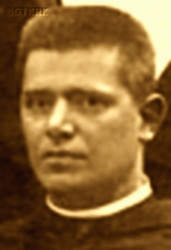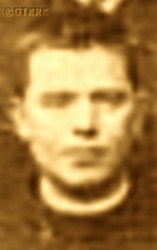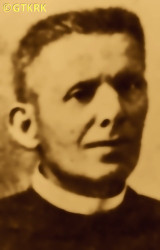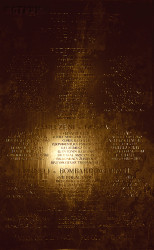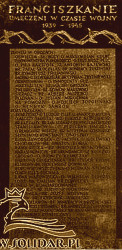Roman Catholic
St Sigismund parish
05-507 Słomczyn
85 Wiślana Str.
Konstancin deanery
Warsaw archdiocese, Poland
full list:
displayClick to display full list

searchClick to search full list by categories
wyświetlKliknij by wyświetlić pełną listę po polsku

szukajKliknij by przeszukać listę wg kategorii po polsku

Martyrology of the clergy — Poland
XX century (1914 – 1989)
personal data
surname
HACZELA
forename(s)
John (pl. Jan)
religious forename(s)
Peregrine (pl. Peregryn)
religious forename(s)
versions/aliases
Pelegrine (pl. Pelegryn)
function
religious cleric
creed
Latin (Roman Catholic) Church RCmore on
en.wikipedia.org
[access: 2014.09.21]
congregation
Order of Friars Minor Conventual OFMConvmore on
en.wikipedia.org
[access: 2013.05.19]
(i.e. Conventual Franciscans)
diocese / province
st Anthony of Padua and bl. James Strzemię province OFMConvmore on
pl.wikipedia.org
[access: 2014.08.18]
academic distinctions
Doctor of Philosophy
Doctor of Theology
date and place
of death
26.07.1942

Stanislavivtoday: Ivano‐Frankivsk, Stanislaviv/Ivano‐Frankivsk rai., Stanislaviv/Ivano‐Frankivsk obl., Ukraine
more on
en.wikipedia.org
[access: 2020.11.20]
alt. dates and places
of death
27.07.1942, 09.08.1942
between Halych and Stanyslavivtoday: Stanislaviv/Ivano‐Frankivsk obl., Ukraine
details of death
After German and Russian invasion of Poland in 09.1939 and start of the World War II, after start of Russian occupation Halych monastery was robbed and all assets appropriated by the Russians.
After German attack on 22.06.1941 of their erstwhile ally, Russians, and start of German occupation the monastery was taken over by the Germans.
arrested in Halych together with Fr Anthony Wójcik and Br Francis Kosiorek by the Ukrainian police, collaborating with Germans, accused of hiding a Jewish girl in a church bell tower and hiding weapons (planted by the Ukrainians themselves).
Transported to Stanislaviv, c. 25 km from Halych.
Tortured for 3 day by German Gestapo.
On the fourth murdered (according to some sources murdered on the day of arrest).
alt. details of death
According to some sources murdered on a road from Halych to Stanislaviv (c. 27.07.1942).
According to others murdered in a mass execution together with a few Jews (c. 09.08.1942).
cause of death
mass murder
perpetrators
Germans / Ukrainians
sites and events
StanislavivClick to display the description, Help to the JewsClick to display the description, GeneralgouvernementClick to display the description, Ribbentrop‐MolotovClick to display the description, Pius XI's encyclicalsClick to display the description
date and place
of birth
26.12.1865Birth certification on:
skanoteka.genealodzy.pl
[access: 2025.04.19]

Odrzykońtoday: Wojaszówka gm., Krosno pov., Subcarpathia voiv., Poland
more on
en.wikipedia.org
[access: 2021.10.09]
parents
HACZELA Joseph
🞲 ?, ? — 🕆 ?, ?

PISZ Catherine
🞲 ?, ? — 🕆 ?, ?
baptism
27.12.1865Birth certification on:
skanoteka.genealodzy.pl
[access: 2025.04.19]

Odrzykońtoday: Wojaszówka gm., Krosno pov., Subcarpathia voiv., Poland
more on
en.wikipedia.org
[access: 2021.10.09]
St Catherine the Virgin and Martyr RC church
religious vows
1886 (temporary)
1889 (permanent)
presbyter (holy orders)
ordination
14.07.1890

Krakówtoday: Kraków city pov., Lesser Poland voiv., Poland
more on
en.wikipedia.org
[access: 2021.06.07]
positions held
1939 – 1942
guardian — Halychtoday: Halych urban hrom., Stanislaviv/Ivano‐Frankivsk rai., Stanislaviv/Ivano‐Frankivsk obl., Ukraine
more on
en.wikipedia.org
[access: 2020.11.20] ⋄ St Stanislav the Bishop and Martyr monastery, Conventual Franciscans OFMConv
1937 – 1939
guardian — Jasłotoday: Jasło urban gm., Jasło pov., Subcarpathia voiv., Poland
more on
en.wikipedia.org
[access: 2021.10.09] ⋄ St Anthony of Padua monastery, Conventual Franciscans OFMConv
1936 – 1937
friar — Jasłotoday: Jasło urban gm., Jasło pov., Subcarpathia voiv., Poland
more on
en.wikipedia.org
[access: 2021.10.09] ⋄ St Anthony of Padua monastery, Conventual Franciscans OFMConv
1930 – 1936
first deputy (assistant) to the general — Conventual Franciscans OFMConv — also: lecturer at St Bonaventure International College „Seraphicum” in Rome
1927 – 1930
professor — Rometoday: Rome prov., Lazio reg., Italy
more on
en.wikipedia.org
[access: 2021.12.18] ⋄ St Bonaventure Bishop and Confessor „Seraphicum” [i.e. Pontifical Faculty of Theology (from 1955), Pontifical College (1935‐1955), College (till 1935)], Conventual Franciscans OFMConv
1924 – 1927
superior — St Anthony and Bl. James Strema of Strzemię coat of arms Polish Province, Conventual Franciscans OFMConv
1920 – 1924
guardian — Warsawtoday: Warsaw city pov., Masovia voiv., Poland
more on
en.wikipedia.org
[access: 2021.10.09] ⋄ St Francis' Stigmas monastery, Conventual Franciscans OFMConv
1919 – 1920
guardian — Vilniustoday: Vilnius city dist., Vilnius Cou., Lithuania
more on
en.wikipedia.org
[access: 2022.01.06] ⋄ Assumption of the Blessed Virgin Mary monastery, Conventual Franciscans OFMConv
1914 – 1919
first deputy (assistant) to the general — Conventual Franciscans OFMConv — also: general socius and teacher of seminarians in the the St Anthony and Bl. James Strema of Strzemię coat of arms' Galicia and Lodomeria Province
1905 – 1914
superior — St Anthony and Bl. James Strema of Strzemię coat of arms' Galicia and Lodomeria Province, Conventual Franciscans OFMConv — also: apostolic visitator of the Pauline Fathers' „on the Rock” monastery in Krakow (1907‐1914) and Province of Hungary
1904 – 1905
guardian — Krakówtoday: Kraków city pov., Lesser Poland voiv., Poland
more on
en.wikipedia.org
[access: 2021.06.07] ⋄ St Francis of Assisi monastery, Conventual Franciscans OFMConv
1902 – 1904
professor — Krakówtoday: Kraków city pov., Lesser Poland voiv., Poland
more on
en.wikipedia.org
[access: 2021.06.07] ⋄ Philosophical and Theological Studies, St Francis of Assisi monastery, Conventual Franciscans OFMConv — lecturer in philosophy and dogmatic theology; also: custodian of Kraków custody of the St Anthony and Bl. James Strema of Strzemię coat of arms' Galicia and Lodomeria Province
1899 – 1902
friar — Lvivtoday: Lviv urban hrom., Lviv rai., Lviv obl., Ukraine
more on
en.wikipedia.org
[access: 2022.01.16] ⋄ Immaculate Conception of the Blessed Virgin Mary monastery, Conventual Franciscans OFMConv — secretary of the St Anthony and Bl. James Strema of Strzemię coat of arms' Galicia and Lodomeria Province
1892 – 1899
professor — Krakówtoday: Kraków city pov., Lesser Poland voiv., Poland
more on
en.wikipedia.org
[access: 2021.06.07] ⋄ Philosophical and Theological Studies, St Francis of Assisi monastery, Conventual Franciscans OFMConv — lecturer in philosophy and dogmatic theology; also: monastery vicar (1893‐1894)
1891 – 1892
friar — Lvivtoday: Lviv urban hrom., Lviv rai., Lviv obl., Ukraine
more on
en.wikipedia.org
[access: 2022.01.16] ⋄ Immaculate Conception of the Blessed Virgin Mary monastery, Conventual Franciscans OFMConv
till 1891
friar — Krakówtoday: Kraków city pov., Lesser Poland voiv., Poland
more on
en.wikipedia.org
[access: 2021.06.07] ⋄ St Francis of Assisi monastery, Conventual Franciscans OFMConv — PhD student at Society of Jesus SI (Jesuits) Theological College at 26 Kopernika Str.
from 1886
friar — Krakówtoday: Kraków city pov., Lesser Poland voiv., Poland
more on
en.wikipedia.org
[access: 2021.06.07] ⋄ St Francis of Assisi monastery, Conventual Franciscans OFMConv — philosophy and theology student at Society of Jesus SI (Jesuits) Theological College at 26 Kopernika Str.
1885 – 1886
novitiate — Lvivtoday: Lviv urban hrom., Lviv rai., Lviv obl., Ukraine
more on
en.wikipedia.org
[access: 2022.01.16] ⋄ Immaculate Conception of the Blessed Virgin Mary monastery, Conventual Franciscans OFMConv
from 14.09.1885
accession — Conventual Franciscans OFMConv
others related
in death
KOSIOREKClick to display biography Francis (Bro. Stephen Mary), WÓJCIKClick to display biography Anthony (Fr Remigius Mary)
sites and events
descriptions
Stanislaviv: Prison used by the Russians (in 1939‐1941 — in 06.1941, when escaping from advancing Germans, Russians perpetrated a mass murder on prison inmates — and from 1944); the Germans (in 1941‐1944); and again by the Russian occupiers after replacing Germans in 1944. Thousands of Poles were jailed there. (more on: stanislawow.netClick to attempt to display webpage
[access: 2014.01.06], stanislawow.netClick to attempt to display webpage
[access: 2014.01.06])
Help to the Jews: During World War II on the Polish occupied territories Germans forbid to give any support to the Jews under penalty of death. Hundreds of Polish priests and religious helped the Jews despite this official sanction. Many of them were caught and murdered.
Generalgouvernement: After the Polish defeat in the 09.1939 campaign, which was the result of the Ribbentrop‐Molotov Pact and constituted the first stage of World War II, and the beginning of German occupation in part of Poland (in the other, eastern part of Poland, the Russian occupation began), the Germans divided the occupied Polish territory into five main regions. In two of them new German provinces were created, two other were incorporated into other provinces. However, the fifth part was treated separately, and in a political sense it was supposed to recreate the German idea from 1915 (during World War I, after the defeat of the Russians in the Battle of Gorlice in 05.1915) of creating a Polish enclave within Germany. Illegal in the sense of international law, i.e. Hague Convention, and public law, managed by the Germans according to separate laws — especially established for the Polish Germ. Untermenschen (Eng. subhumans) — till the Russian offensive in 1945 it constituted part of the Germ. Großdeutschland (Eng. Greater Germany). Till 31.07.1940 formally called Germ. Generalgouvernement für die besetzten polnischen Gebiete (Eng. General Government for the occupied Polish lands) — later simply Germ. Generalgouvernement (Eng. General Governorate), as in the years 1915‐1918. From 07.1941, i.e. after the German attack on 22.06.1941 against the erstwhile ally, the Russians, it also included the Galicia district, i.e. the Polish pre‐war south‐eastern voivodeships. A special criminal law was enacted and applied to Poles and Jews, allowing for the arbitrary administration of the death penalty regardless of the age of the „perpetrator”, and sanctioning the use of collective responsibility. After the end of the military conflict of the World War UU, the government of the Germ. Generalgouvernement was recognized as a criminal organization, and its leader, governor Hans Frank, guilty of war crimes and crimes against humanity and executed. (more on: en.wikipedia.orgClick to attempt to display webpage
[access: 2024.12.13])
Ribbentrop‐Molotov: Genocidal Russian‐German alliance pact between Russian leader Joseph Stalin and German leader Adolf Hitler signed on 23.08.1939 in Moscow by respective foreign ministers, Mr. Vyacheslav Molotov for Russia and Joachim von Ribbentrop for Germany. The pact sanctioned and was the direct cause of joint Russian and German invasion of Poland and the outbreak of the World War II in 09.1939. In a political sense, the pact was an attempt to restore the status quo ante before 1914, with one exception, namely the „commercial” exchange of the so‐called „Kingdom of Poland”, which in 1914 was part of the Russian Empire, fore Eastern Galicia (today's western Ukraine), in 1914 belonging to the Austro‐Hungarian Empire. Galicia, including Lviv, was to be taken over by the Russians, the „Kingdom of Poland” — under the name of the General Governorate — Germany. The resultant „war was one of the greatest calamities and dramas of humanity in history, for two atheistic and anti‐Christian ideologies — national and international socialism — rejected God and His fifth Decalogue commandment: Thou shall not kill!” (Abp Stanislav Gądecki, 01.09.2019). The decisions taken — backed up by the betrayal of the formal allies of Poland, France and Germany, which on 12.09.1939, at a joint conference in Abbeville, decided not to provide aid to attacked Poland and not to take military action against Germany (a clear breach of treaty obligations with Poland) — were on 28.09.1939 slightly altered and made more precise when a treaty on „German‐Russian boundaries and friendship” was agreed by the same murderous signatories. One of its findings was establishment of spheres of influence in Central and Eastern Europe and in consequence IV partition of Poland. In one of its secret annexes agreed, that: „the Signatories will not tolerate on its respective territories any Polish propaganda that affects the territory of the other Side. On their respective territories they will suppress all such propaganda and inform each other of the measures taken to accomplish it”. The agreements resulted in a series of meeting between two genocidal organization representing both sides — German Gestapo and Russian NKVD when coordination of efforts to exterminate Polish intelligentsia and Polish leading classes (in Germany called «Intelligenzaktion», in Russia took the form of Katyń massacres) where discussed. Resulted in deaths of hundreds of thousands of Polish intelligentsia, including thousands of priests presented here, and tens of millions of ordinary people,. The results of this Russian‐German pact lasted till 1989 and are still in evidence even today. (more on: en.wikipedia.orgClick to attempt to display webpage
[access: 2015.09.30])
Pius XI's encyclicals: Facing the creation of two totalitarian systems in Europe, which seemed to compete with each other, though there were more similarities than contradictions between them, Pope Pius XI issued in 03.1937 (within 5 days) two encyclicals. In the „Mit brennender Sorge” (Eng. „With Burning Concern”) published on 14.03.1938, condemned the national socialism prevailing in Germany. The Pope wrote: „Whoever, following the old Germanic‐pre‐Christian beliefs, puts various impersonal fate in the place of a personal God, denies the wisdom of God and Providence […], whoever exalts earthly values: race or nation, or state, or state system, representatives of state power or other fundamental values of human society, […] and makes them the highest standard of all values, including religious ones, and idolizes them, this one […] is far from true faith in God and from a worldview corresponding to such faith”. On 19.03.1937, published „Divini Redemptoris” (Eng. „Divine Redeemer”), in which criticized Russian communism, dialectical materialism and the class struggle theory. The Pope wrote: „Communism deprives man of freedom, and therefore the spiritual basis of all life norms. It deprives the human person of all his dignity and any moral support with which he could resist the onslaught of blind passions […] This is the new gospel that Bolshevik and godless communism preaches as a message of salvation and redemption of humanity”… Pius XI demanded that the established human law be subjected to the natural law of God , recommended the implementation of the ideal of a Christian state and society, and called on Catholics to resist. Two years later, National Socialist Germany and Communist Russia came together and started World War II. (more on: www.vatican.vaClick to attempt to display webpage
[access: 2023.05.28], www.vatican.vaClick to attempt to display webpage
[access: 2023.05.28])
sources
personal:
www.bj.uj.edu.plClick to attempt to display webpage
[access: 2012.11.23], cracovia-leopolis.plClick to attempt to display webpage
[access: 2013.01.06], skanoteka.genealodzy.plClick to attempt to display webpage
[access: 2025.04.19], pl.wikipedia.orgClick to attempt to display webpage
[access: 2013.01.13]
bibliographical:
„Martyrology of the Polish Roman Catholic clergy under nazi occupation in 1939‐1945”, Victor Jacewicz, John Woś, vol. I‐V, Warsaw Theological Academy, 1977‐1981
„Register of Latin rite Lviv metropolis clergy’s losses in 1939‐45”, Józef Krętosz, Maria Pawłowiczowa, editors, Opole, 2005
„Biographical lexicon of Lviv Roman Catholic Metropoly clergy victims of the II World War 1939‐1945”, Mary Pawłowiczowa (ed.), Fr Joseph Krętosz (ed.), Holy Cross Publishing, Opole, 2007
„Biographical–bibliographical dictionary of Polish Conventual Franciscan Fathers murdered and tragically dead in 1939‐1945”, Lukas Janecki, Franciscan Fathers’ Publishing House, Niepokalanów, 2016
original images:
www.rodzinaoswiecimska.plClick to attempt to display webpage
[access: 2016.11.06], genealodzy.plClick to attempt to display webpage
[access: 2013.08.10], www.sowiniec.com.plClick to attempt to display webpage
[access: 2014.07.11]
LETTER to CUSTODIAN/ADMINISTRATOR
If you have an Email client on your communicator/computer — such as Mozilla Thunderbird, Windows Mail or Microsoft Outlook, described at WikipediaPatrz:
en.wikipedia.org, among others — try the link below, please:
LETTER to CUSTODIAN/ADMINISTRATORClick and try to call your own Email client
If however you do not run such a client or the above link is not active please send an email to the Custodian/Administrator using your account — in your customary email/correspondence engine — at the following address:

giving the following as the subject:
MARTYROLOGY: HACZELA John
To return to the biography press below:
 Click to return to biography
Click to return to biography








